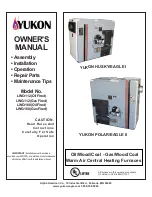
MF47-3.05
6
Take care that nothing hits the elements when loading of unloading.
3.5
Opening the Door
Take great care when loading or unloading the furnace chamber. See section 3.3. Before you
remove a hot object from the furnace make sure you have a safe place to put it down.
Do not open the door at high temperatures. If possible, do not open it above 200°C. If it is
necessary to load or unload work at elevated temperatures, keep the door open for as short a period
as possible. The insulation cools quickly and may crack through thermal shock.
The heating elements and the insulation are very susceptible to mechanical shock. At all times
operate the door gently to avoid mechanical shock.
Opening the door when the furnace is very hot can cause hot air to be sucked by the case cooling
fans towards the thermal cutout and activate it (see section 3.13). Avoid excessive door opening
and shut it as soon as possible.
3.6
Insulation Cracking
In these furnaces the insulation material is susceptible to surface cracking arising from high
temperature cycling; this is a normal occurrence and such cracking is not detrimental to the
performance of the furnace.
3.7
Atmospheres & Corrosive Materials
In oxidising atmospheres, metal oxides react with the silica layer on the surface of the elements
and may lead to premature failure. Protect the elements from splashes of molten metal and dust
when charging the furnace, and from fumes developed when melting, especially from fluxes. Also
avoid compounds with a high alkali content.
The furnace is designed for use up to its maximum temperature in oxidising atmospheres, but can
also be operated successfully in neutral or carburising atmospheres. It may be used with nitrogen,
argon or helium atmospheres to 1600°C. Reducing atmospheres are not recommended. Sulphur
dioxide in normal concentrations is not harmful, but chlorine, and more so fluorine, strongly attack
even oxidised elements and should be avoided.
The furnace is not recommended for burning off carbonaceous materials. Other Carbolite furnaces
are available for this application.
When an optional gas inlet is fitted there is a label near the inlet saying "INERT GAS ONLY". In
practice
inert
or
oxidising
gases may be used, but
not combustible or toxic gases
. The furnaces are
not gas tight, so it should be understood that gas usage may be high, and that the chamber is likely
always to contain some air. Residual oxygen levels of at least 1% are to be expected.
The hearth can be protected from abrasion, by the provision of a secondary plate. This consumable
item can either be in light weight ceramic fibre or in dense, hard-wearing alumina refractory.
3.8
Pesting
The furnace is fitted with Molybdenum Disilicide elements and is therefore susceptible to pesting.
Pesting can be seen as a yellowish crystal growth on the surface of the element. It occurs when the
element surface temperature is around 450°C and is caused by the air oxidising with the
Molybdenum in the element compound. Under normal operating conditions (above 800°C)
pesting is not a problem and can often be seen occurring naturally on the element terminals.
Running the furnace for prolonged periods at temperatures below 600°C will cause pesting to
occur on the element surface and will eventually damage the elements.
Heating on a slow ramp rate or dwelling at temperatures below 600°C for short periods will not
cause a problem providing the furnace is run above 1400°C at regular intervals to recondition the
element surfaces.
Large amounts of pesting occurring on the element terminals must be removed in accordance with
good health and safety practices.






































